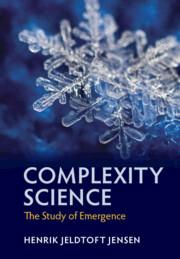This project is concerned with the review article Connectivity and complex systems: Learning from a multi-disciplinary perspective
Question:
This project is concerned with the review article ‘Connectivity and complex systems:
Learning from a multi-disciplinary perspective’ [459]. The article is rather long, but a very detailed reading is not needed. It suffices to skim read to become familiar with the authors’ use of the terms
(1) Emergence.
(2) Structural connectivity vs. fundamental connectivity.
(3) Fundamental unit.
Next we want to think about the way these three concepts are developed and used in the review in relation to the discussion in Chaps. 1 and 2.
(a) Consider the definition of emergence and complexity science given in the summary to Chap. 1 and discuss a comparison with the review article’s notion of item (1) above.
(b) Discuss item (2) above in light of the discussion of processes in Sec. 1.1.
(c) Relate item (3) to the notion of robust degrees of freedom discussed in Sec. 2.2, structural coherence discussed in Sec. 2.3 and breaking of symmetry discussed in Sec. 2.5.
The authors say on page 6: ‘However, deriving quantitative descriptions of emergent behaviour is challenging. Theoretical tools to relate emergent behaviour to structure and function are lacking, and by separating SC from FC we make it even more difficult to analyse emergent behaviour.’
We can use this somewhat pessimistic view as a motivation to take a look at what the present book presents as available tools for the analysis of emergence. Go through the Synopsis paragraph at the beginning of each of the chapters of Part II.
(d) Now think for a moment about how the view and conclusions of this multidisciplinary review might have changed had it included mathematics, statistical mechanics and information among the disciplines.
Learning from a multi-disciplinary perspective’ [459]. The article is rather long, but a very detailed reading is not needed. It suffices to skim read to become familiar with the authors’ use of the terms
(1) Emergence.
(2) Structural connectivity vs. fundamental connectivity.
(3) Fundamental unit.
Next we want to think about the way these three concepts are developed and used in the review in relation to the discussion in Chaps. 1 and 2.
(a) Consider the definition of emergence and complexity science given in the summary to Chap. 1 and discuss a comparison with the review article’s notion of item (1) above.
(b) Discuss item (2) above in light of the discussion of processes in Sec. 1.1.
(c) Relate item (3) to the notion of robust degrees of freedom discussed in Sec. 2.2, structural coherence discussed in Sec. 2.3 and breaking of symmetry discussed in Sec. 2.5.
The authors say on page 6: ‘However, deriving quantitative descriptions of emergent behaviour is challenging. Theoretical tools to relate emergent behaviour to structure and function are lacking, and by separating SC from FC we make it even more difficult to analyse emergent behaviour.’
We can use this somewhat pessimistic view as a motivation to take a look at what the present book presents as available tools for the analysis of emergence. Go through the Synopsis paragraph at the beginning of each of the chapters of Part II.
(d) Now think for a moment about how the view and conclusions of this multidisciplinary review might have changed had it included mathematics, statistical mechanics and information among the disciplines.
Fantastic news! We've Found the answer you've been seeking!
Step by Step Answer:
Related Book For 

Complexity Science The Study Of Emergence
ISBN: 9781108834766
1st Edition
Authors: Henrik Jeldtoft Jensen
Question Posted:





